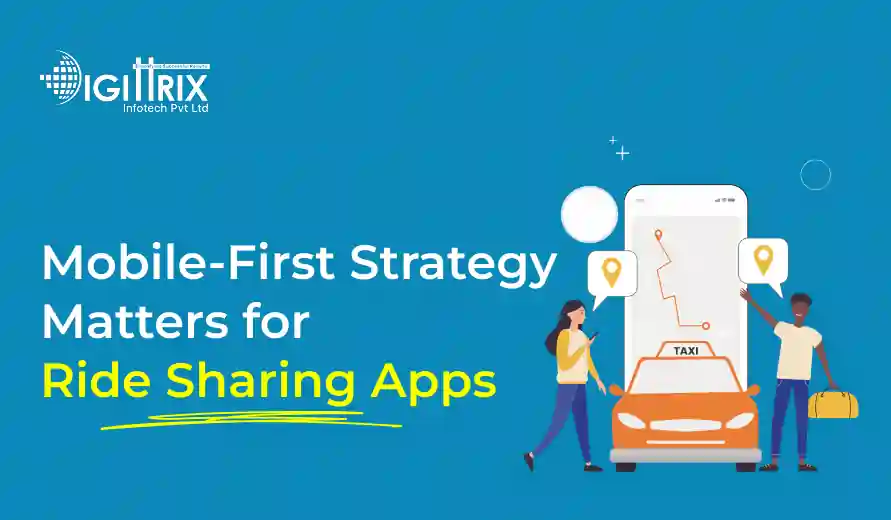Mobile-first apps enhance user experience, shorten booking times, boost engagement, and increase retention, making them a vital solution for fast, convenient, and accessible services today.
Highlights
With Over 14 years of Experience in the IT Field, Helping Companies Optimise there Products for more Conversions

In today’s fast-paced world, people expect services to be quick, convenient, and easily accessible at their fingertips. Ride sharing has become a crucial part of urban transportation, offering an alternative to traditional taxis and public transit. With the widespread use of smartphones, a mobile-first approach in ride-sharing apps has become vital for their success. Transportation companies aiming to compete effectively must focus on mobile-friendly design to meet user expectations and industry standards.
Interested in improving ride efficiency? Check out Digittrix’s article on smart routing algorithms for shared rides to learn how technology optimizes routes!
A mobile-first strategy involves designing a product primarily for mobile devices before adjusting it for larger screens like tablets or desktops. This approach focuses on enhancing the user experience on smartphones, which are the main devices used to access services such as ride sharing. In ride sharing, where users need quick access to booking, tracking, and payment options, a mobile-first approach ensures that the app functions efficiently and intuitively.
Mobile-first design focuses on simplicity, speed, and usability. It requires app developers to carefully prioritize features that matter most to users and remove unnecessary clutter. For ride-sharing apps, these features include quick ride booking, live vehicle tracking, in-app payments, and easy access to support. By emphasizing mobile, developers ensure that users can perform all essential tasks smoothly without frustration or delays.
Smartphones are now the most popular devices for accessing digital services. Many users rely on their mobile phones for tasks ranging from communication to transportation. In ride sharing, most prefer using apps on their smartphones instead of visiting a website. This makes mobile-first design a logical choice for ridesharing app development. By focusing on mobile usability, businesses can reach users where they are most active and increase overall engagement.
Ride sharing focuses on convenience. Users want to quickly book a ride, track the driver in real time, and pay without leaving the app. A mobile-first approach helps the app prioritize these actions, reducing load times and providing a smoother experience. On-demand ride-sharing users often make fast decisions, and any delay or complication can lead to lost customers. Therefore, building a mobile-first platform ensures that key functions are fast, accessible, and easy to use.
A mobile-first approach urges developers to prioritize performance optimization for smartphones. Different from desktop applications, mobile devices have constraints in processing power, screen size, and connectivity. This is particularly crucial for taxi booking app development, where app speed and responsiveness directly influence user satisfaction.
Mobile-first design requires designers to simplify the user interface. Complex menus, multiple options, and excessive graphics can slow down an app and confuse users. By focusing on the mobile experience, designers create a clean, intuitive interface that guides users step by step through the booking process. This simplicity is essential in carpooling app development, where users want to easily book rides, check availability, and communicate with drivers.
Designing a mobile-first ride-sharing app isn't just about resizing the layout for smaller screens. It also focuses on highlighting features that make the app practical, efficient, and easy to use. Some key features include:
Users should be able to book rides with just a few taps. A mobile-first design simplifies the booking process, allowing users to enter their destination, select a vehicle type, and confirm their ride quickly. For an on-demand ridesharing app, this feature is crucial because speed is a main reason users prefer app-based transportation over traditional taxis.
Tracking the driver’s location in real time is among the most requested features in ride-sharing apps. A mobile-first design ensures that maps load quickly, updates happen often, and navigation details are easy to read on small screens. Whether it’s a standard taxi or a carpool option, users feel safer and more informed when tracking is accurate and immediate.
Mobile users expect easy and secure ways to pay. Including different payment options like credit cards, digital wallets, and UPI lets users finish transactions within the app. A mobile-first design makes the payment process simple, reduces mistakes, and builds trust in the platform. For taxi booking app development, making sure payment security is in place is key to attracting and keeping users.
Mobile-first ride-sharing apps make it simple for users to leave feedback after a ride. This feature helps uphold service quality and encourages drivers to provide better experiences. A user-friendly, mobile-optimized interface allows users to rate drivers or leave comments easily, which is crucial for building trust in the competitive ridesharing industry.
Push notifications are an effective way to keep users informed about ride confirmations, driver arrivals, discounts, or special deals. Mobile-first apps allow developers to customize notifications so they are timely, relevant, and unobtrusive. This boosts engagement and user satisfaction without overwhelming users.
As the number of leading ridesharing apps increases, adopting a mobile-first approach gives businesses a competitive edge. Users prefer apps that are easy to navigate, load quickly, and fulfill their needs. Ride-sharing companies that prioritize mobile experience can attract and retain more customers, gaining an advantage over competitors who pay less attention to mobile usability.
Mobile-first development can be more cost-effective over time. By addressing mobile performance and usability issues early, businesses avoid costly revisions later on. Ridesharing app development companies can build apps that require fewer updates and less maintenance, reducing costs and enabling better resource allocation to the most important features.
Apps that perform well on mobile devices encourage users to keep coming back. Users are unlikely to remain loyal to a ride-sharing app that crashes, loads slowly, or is difficult to use. By focusing on mobile, businesses ensure a positive experience each time, which boosts retention and loyalty.
Mobile devices are widely used across various demographics and regions. A mobile-first app can connect with users who might not have access to desktop computers or prefer using smartphones. Carpooling app development benefits from this approach, as mobile access allows users to find rides quickly, even in areas with limited transportation options.
While a mobile-first strategy offers many benefits, it also presents challenges that businesses and developers need to address.
Many different mobile devices have varying screen sizes, operating systems, and performance capabilities. Ridesharing app development companies must ensure their app functions reliably across all devices. This requires thorough testing and careful design choices to prevent issues with functionality or slow performance.
Ride-sharing apps rely heavily on real-time data such as maps and GPS tracking. Mobile users might face varying internet connections that can affect app performance. A mobile-first design must account for low-bandwidth scenarios and ensure that key features continue to function even with weak network signals.
Handling sensitive user information, such as payment details and location data, is an essential responsibility. Mobile-first apps must implement strong security measures to prevent data breaches and protect users. This is especially important for taxi booking app development, where trust is key to gaining users.
The ride-sharing market is highly competitive, with many leading ridesharing apps vying for attention. A mobile-first strategy alone isn't enough; businesses must also focus on unique features, affordability, and service quality to stay competitive.
Thinking of launching a ride-sharing app? Read Digittrix’s guide on building a ride-sharing platform like CityHop to get started!
The mobile-first approach has become crucial in the ride-sharing industry. Users expect apps to be fast, intuitive, and simple to use on their smartphones. By focusing on mobile usability, ridesharing companies can boost user engagement, improve conversion rates, and stay competitive. Whether it involves on-demand ridesharing apps, taxi booking platforms, or carpooling services, a mobile-first design ensures that users have a seamless and satisfying experience.
Ridesharing app development companies that adopt this strategy can create solutions that perform well on mobile devices, meet user needs, and stand out in a competitive market. The mobile-first approach is more than just a design choice; it is a practical method that matches how modern users interact with technology and transportation services.
For businesses aiming to invest in ride-sharing platforms, emphasizing a mobile-first design is essential for developing an app that performs well, pleases users, and competes effectively with today's leading ride-sharing apps. Through careful planning, a focus on user needs, and efficient development strategies, mobile-first ride-sharing apps can become the top choice for users worldwide.
Ride-sharing apps continue to transform urban transportation, offering convenient and affordable travel options. In 2025, platforms like Uber and BlaBlaCar remain popular, while new apps introduce improved features for both riders and drivers.
For businesses looking to enter this growing market, choosing the right ridesharing app development company is essential. At Digittrix, we specialize in mobile-first on-demand ridesharing app solutions, whether you need a ready-to-launch platform or a fully custom application. Our team guarantees a smooth development process, with secure payment options, easy-to-use booking systems, and real-time driver tracking.
Looking to launch a carpooling app or develop an Uber alternative to expand your business? Contact our experts today at +91 8727000867 or email digittrix@gmail.com.
Let Digittrix help you create a feature-rich taxi booking app designed for modern commuters, optimized for mobile users, and ready to compete with the best ridesharing apps on the market.

Do you need help in Mobile App development?




Join over 1500+ businesses we've already helped!
Mobile-first design focuses on creating an app for smartphones first, ensuring speed, usability, and essential features before adapting it for larger screens.
Most users access services through smartphones. A mobile-first approach makes booking, tracking, and payment fast and convenient.
It optimizes the app for speed, reduces loading times, and ensures smooth functioning on devices with different screen sizes and processing capabilities.
Yes. It allows users to quickly find and confirm shared rides, track routes, and communicate efficiently through the app.

©2025Digittrix Infotech Private Limited , All rights reserved.